Company Law Assignment - Incorporation, Liability, and Legal Actions
VerifiedAdded on 2020/03/23
|7
|2539
|190
Homework Assignment
AI Summary
This assignment solution addresses key concepts in company law, focusing on the process of company incorporation in Australia, referencing the Corporations Act 2001 and ASIC guidelines. It details the necessary steps, including choosing a company type (proprietary or public), selecting a company name, deciding on internal governance through replaceable rules or a constitution, and providing share details. The solution also outlines the duties and responsibilities of company officers, including directors and secretaries, and the requirements for registered offices and ACN usage. Furthermore, the assignment explores the concept of limited liability and provides advice on structuring a business as a limited liability company. The second part of the solution examines the legal actions that can be taken against a company, particularly in situations where the corporate veil might be pierced, such as when a holding company controls a subsidiary, and the subsidiary's actions cause harm. The assignment discusses the legal principles and cases related to piercing the corporate veil, including situations of fraud, sham, or where a holding company's control warrants liability for the actions of its subsidiary. The solution also considers the rights of employees to bring actions against a company under specific sections of the Corporations Act.

1
Cover Sheet
Name of the student
Student ID
Word count
Cover Sheet
Name of the student
Student ID
Word count
Paraphrase This Document
Need a fresh take? Get an instant paraphrase of this document with our AI Paraphraser
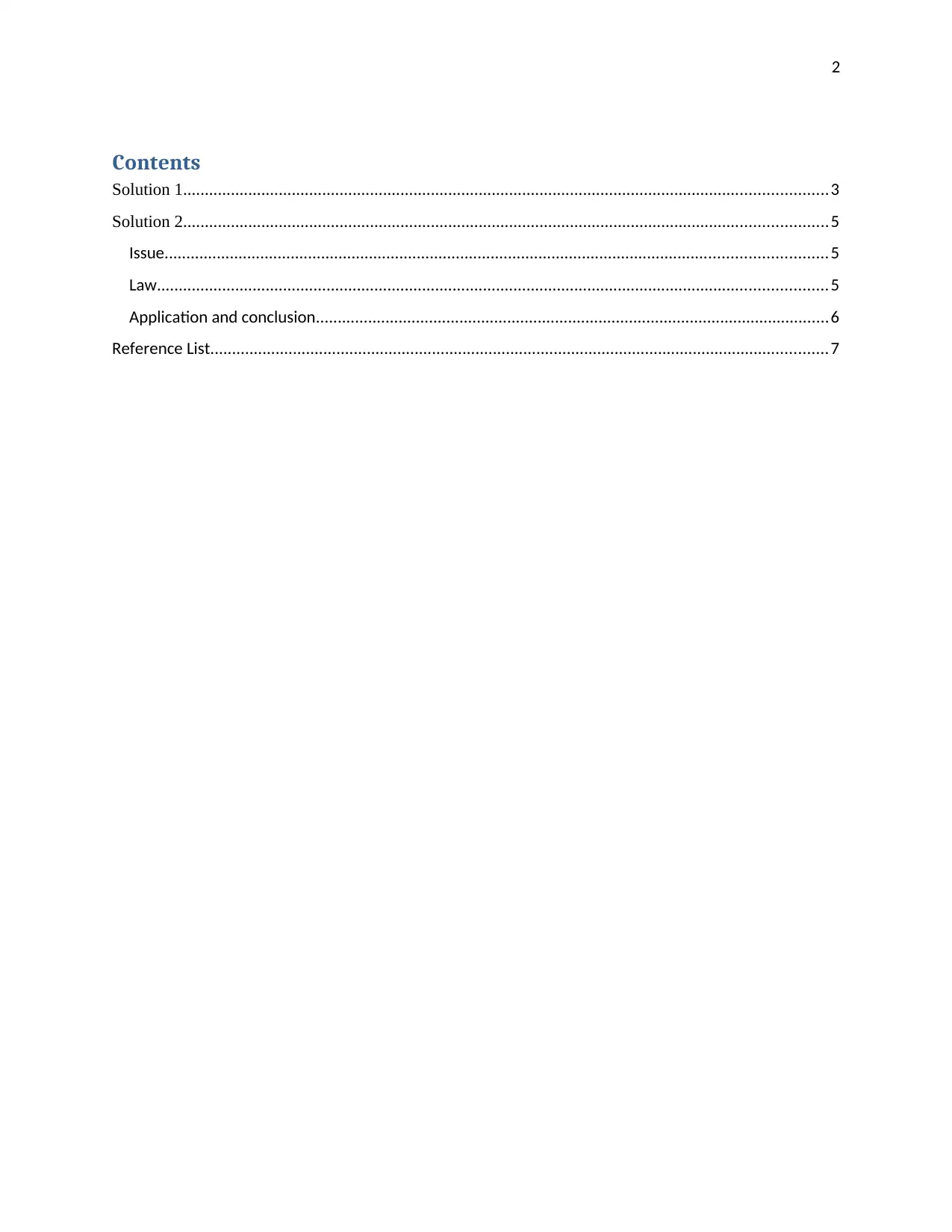
2
Contents
Solution 1....................................................................................................................................................3
Solution 2....................................................................................................................................................5
Issue........................................................................................................................................................5
Law..........................................................................................................................................................5
Application and conclusion......................................................................................................................6
Reference List..............................................................................................................................................7
Contents
Solution 1....................................................................................................................................................3
Solution 2....................................................................................................................................................5
Issue........................................................................................................................................................5
Law..........................................................................................................................................................5
Application and conclusion......................................................................................................................6
Reference List..............................................................................................................................................7
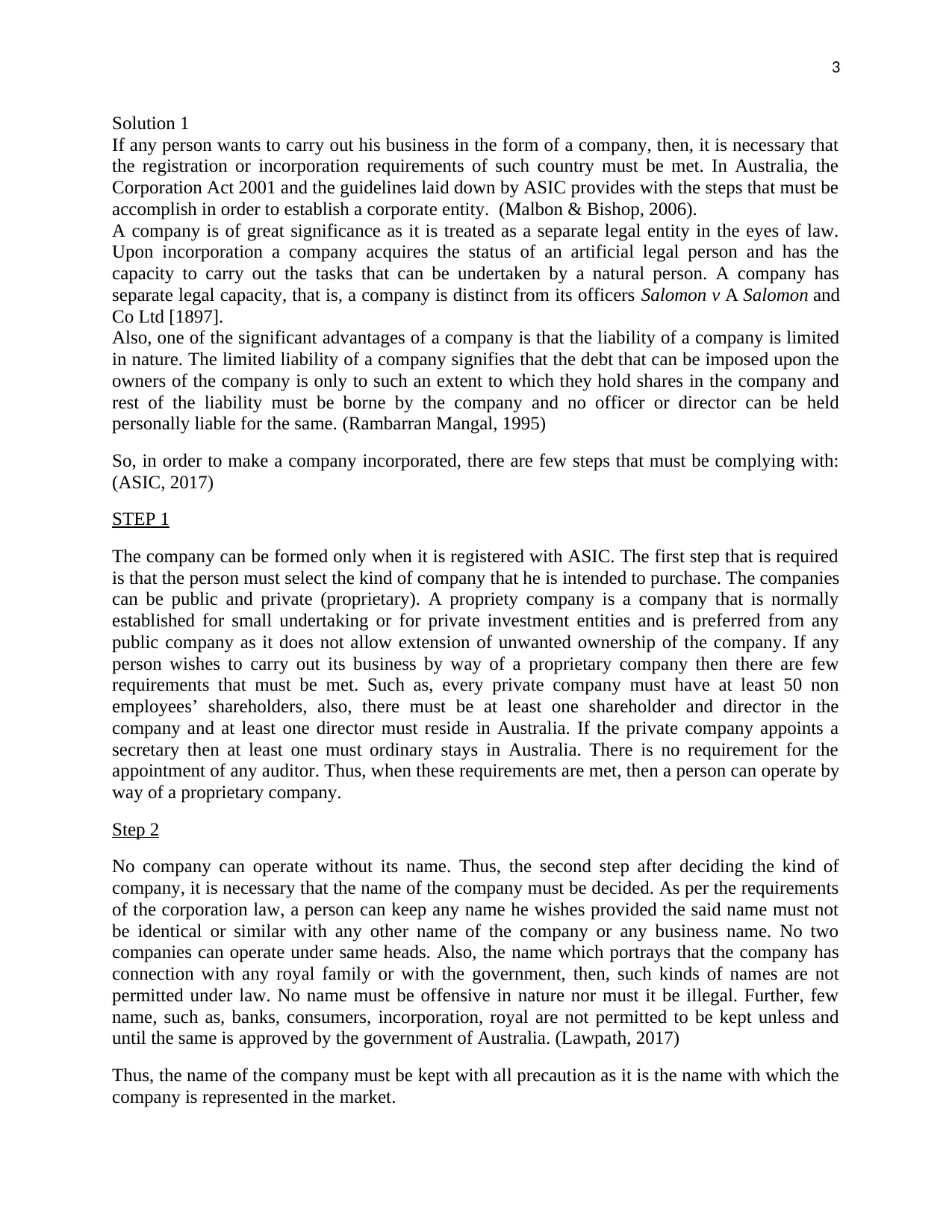
3
Solution 1
If any person wants to carry out his business in the form of a company, then, it is necessary that
the registration or incorporation requirements of such country must be met. In Australia, the
Corporation Act 2001 and the guidelines laid down by ASIC provides with the steps that must be
accomplish in order to establish a corporate entity. (Malbon & Bishop, 2006).
A company is of great significance as it is treated as a separate legal entity in the eyes of law.
Upon incorporation a company acquires the status of an artificial legal person and has the
capacity to carry out the tasks that can be undertaken by a natural person. A company has
separate legal capacity, that is, a company is distinct from its officers Salomon v A Salomon and
Co Ltd [1897].
Also, one of the significant advantages of a company is that the liability of a company is limited
in nature. The limited liability of a company signifies that the debt that can be imposed upon the
owners of the company is only to such an extent to which they hold shares in the company and
rest of the liability must be borne by the company and no officer or director can be held
personally liable for the same. (Rambarran Mangal, 1995)
So, in order to make a company incorporated, there are few steps that must be complying with:
(ASIC, 2017)
STEP 1
The company can be formed only when it is registered with ASIC. The first step that is required
is that the person must select the kind of company that he is intended to purchase. The companies
can be public and private (proprietary). A propriety company is a company that is normally
established for small undertaking or for private investment entities and is preferred from any
public company as it does not allow extension of unwanted ownership of the company. If any
person wishes to carry out its business by way of a proprietary company then there are few
requirements that must be met. Such as, every private company must have at least 50 non
employees’ shareholders, also, there must be at least one shareholder and director in the
company and at least one director must reside in Australia. If the private company appoints a
secretary then at least one must ordinary stays in Australia. There is no requirement for the
appointment of any auditor. Thus, when these requirements are met, then a person can operate by
way of a proprietary company.
Step 2
No company can operate without its name. Thus, the second step after deciding the kind of
company, it is necessary that the name of the company must be decided. As per the requirements
of the corporation law, a person can keep any name he wishes provided the said name must not
be identical or similar with any other name of the company or any business name. No two
companies can operate under same heads. Also, the name which portrays that the company has
connection with any royal family or with the government, then, such kinds of names are not
permitted under law. No name must be offensive in nature nor must it be illegal. Further, few
name, such as, banks, consumers, incorporation, royal are not permitted to be kept unless and
until the same is approved by the government of Australia. (Lawpath, 2017)
Thus, the name of the company must be kept with all precaution as it is the name with which the
company is represented in the market.
Solution 1
If any person wants to carry out his business in the form of a company, then, it is necessary that
the registration or incorporation requirements of such country must be met. In Australia, the
Corporation Act 2001 and the guidelines laid down by ASIC provides with the steps that must be
accomplish in order to establish a corporate entity. (Malbon & Bishop, 2006).
A company is of great significance as it is treated as a separate legal entity in the eyes of law.
Upon incorporation a company acquires the status of an artificial legal person and has the
capacity to carry out the tasks that can be undertaken by a natural person. A company has
separate legal capacity, that is, a company is distinct from its officers Salomon v A Salomon and
Co Ltd [1897].
Also, one of the significant advantages of a company is that the liability of a company is limited
in nature. The limited liability of a company signifies that the debt that can be imposed upon the
owners of the company is only to such an extent to which they hold shares in the company and
rest of the liability must be borne by the company and no officer or director can be held
personally liable for the same. (Rambarran Mangal, 1995)
So, in order to make a company incorporated, there are few steps that must be complying with:
(ASIC, 2017)
STEP 1
The company can be formed only when it is registered with ASIC. The first step that is required
is that the person must select the kind of company that he is intended to purchase. The companies
can be public and private (proprietary). A propriety company is a company that is normally
established for small undertaking or for private investment entities and is preferred from any
public company as it does not allow extension of unwanted ownership of the company. If any
person wishes to carry out its business by way of a proprietary company then there are few
requirements that must be met. Such as, every private company must have at least 50 non
employees’ shareholders, also, there must be at least one shareholder and director in the
company and at least one director must reside in Australia. If the private company appoints a
secretary then at least one must ordinary stays in Australia. There is no requirement for the
appointment of any auditor. Thus, when these requirements are met, then a person can operate by
way of a proprietary company.
Step 2
No company can operate without its name. Thus, the second step after deciding the kind of
company, it is necessary that the name of the company must be decided. As per the requirements
of the corporation law, a person can keep any name he wishes provided the said name must not
be identical or similar with any other name of the company or any business name. No two
companies can operate under same heads. Also, the name which portrays that the company has
connection with any royal family or with the government, then, such kinds of names are not
permitted under law. No name must be offensive in nature nor must it be illegal. Further, few
name, such as, banks, consumers, incorporation, royal are not permitted to be kept unless and
until the same is approved by the government of Australia. (Lawpath, 2017)
Thus, the name of the company must be kept with all precaution as it is the name with which the
company is represented in the market.
⊘ This is a preview!⊘
Do you want full access?
Subscribe today to unlock all pages.

Trusted by 1+ million students worldwide
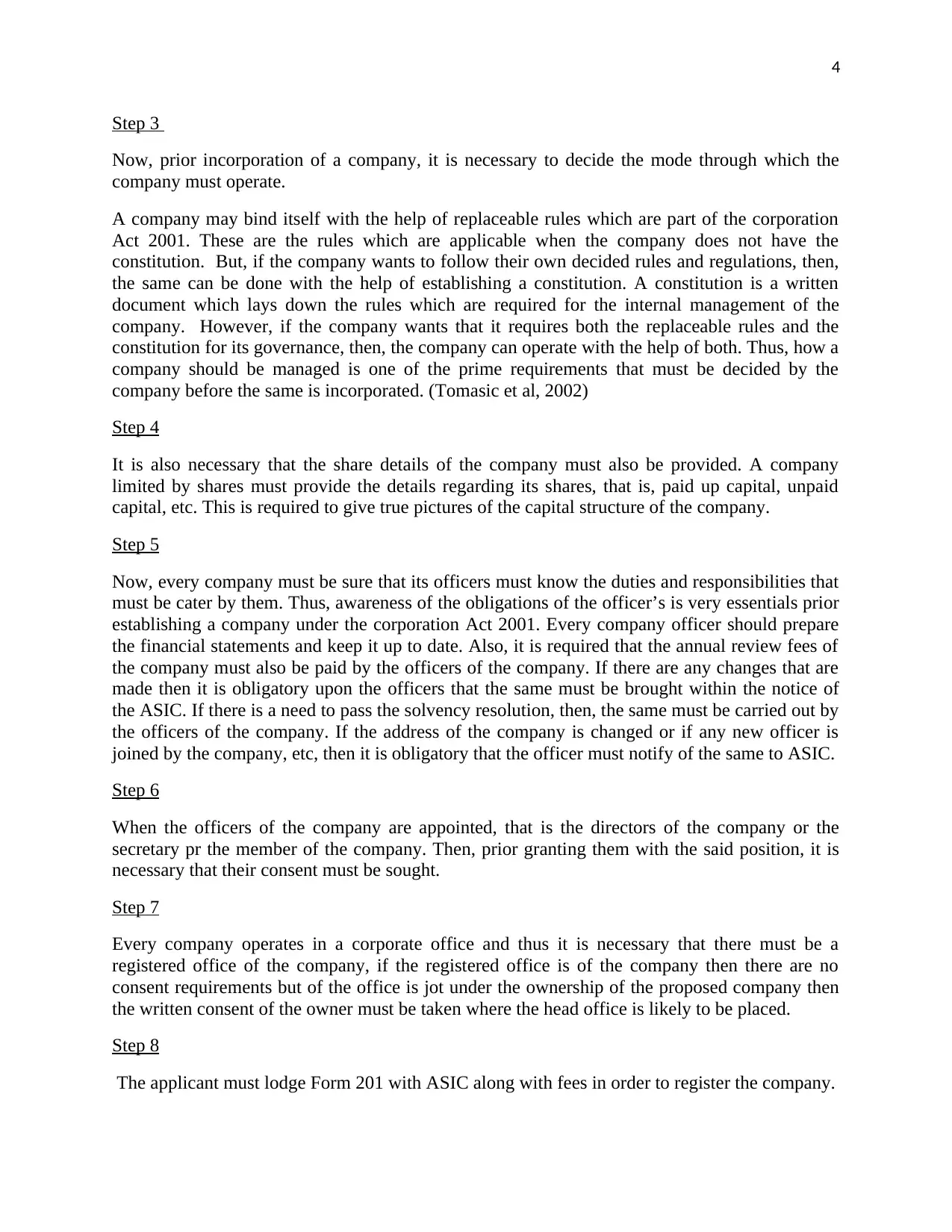
4
Step 3
Now, prior incorporation of a company, it is necessary to decide the mode through which the
company must operate.
A company may bind itself with the help of replaceable rules which are part of the corporation
Act 2001. These are the rules which are applicable when the company does not have the
constitution. But, if the company wants to follow their own decided rules and regulations, then,
the same can be done with the help of establishing a constitution. A constitution is a written
document which lays down the rules which are required for the internal management of the
company. However, if the company wants that it requires both the replaceable rules and the
constitution for its governance, then, the company can operate with the help of both. Thus, how a
company should be managed is one of the prime requirements that must be decided by the
company before the same is incorporated. (Tomasic et al, 2002)
Step 4
It is also necessary that the share details of the company must also be provided. A company
limited by shares must provide the details regarding its shares, that is, paid up capital, unpaid
capital, etc. This is required to give true pictures of the capital structure of the company.
Step 5
Now, every company must be sure that its officers must know the duties and responsibilities that
must be cater by them. Thus, awareness of the obligations of the officer’s is very essentials prior
establishing a company under the corporation Act 2001. Every company officer should prepare
the financial statements and keep it up to date. Also, it is required that the annual review fees of
the company must also be paid by the officers of the company. If there are any changes that are
made then it is obligatory upon the officers that the same must be brought within the notice of
the ASIC. If there is a need to pass the solvency resolution, then, the same must be carried out by
the officers of the company. If the address of the company is changed or if any new officer is
joined by the company, etc, then it is obligatory that the officer must notify of the same to ASIC.
Step 6
When the officers of the company are appointed, that is the directors of the company or the
secretary pr the member of the company. Then, prior granting them with the said position, it is
necessary that their consent must be sought.
Step 7
Every company operates in a corporate office and thus it is necessary that there must be a
registered office of the company, if the registered office is of the company then there are no
consent requirements but of the office is jot under the ownership of the proposed company then
the written consent of the owner must be taken where the head office is likely to be placed.
Step 8
The applicant must lodge Form 201 with ASIC along with fees in order to register the company.
Step 3
Now, prior incorporation of a company, it is necessary to decide the mode through which the
company must operate.
A company may bind itself with the help of replaceable rules which are part of the corporation
Act 2001. These are the rules which are applicable when the company does not have the
constitution. But, if the company wants to follow their own decided rules and regulations, then,
the same can be done with the help of establishing a constitution. A constitution is a written
document which lays down the rules which are required for the internal management of the
company. However, if the company wants that it requires both the replaceable rules and the
constitution for its governance, then, the company can operate with the help of both. Thus, how a
company should be managed is one of the prime requirements that must be decided by the
company before the same is incorporated. (Tomasic et al, 2002)
Step 4
It is also necessary that the share details of the company must also be provided. A company
limited by shares must provide the details regarding its shares, that is, paid up capital, unpaid
capital, etc. This is required to give true pictures of the capital structure of the company.
Step 5
Now, every company must be sure that its officers must know the duties and responsibilities that
must be cater by them. Thus, awareness of the obligations of the officer’s is very essentials prior
establishing a company under the corporation Act 2001. Every company officer should prepare
the financial statements and keep it up to date. Also, it is required that the annual review fees of
the company must also be paid by the officers of the company. If there are any changes that are
made then it is obligatory upon the officers that the same must be brought within the notice of
the ASIC. If there is a need to pass the solvency resolution, then, the same must be carried out by
the officers of the company. If the address of the company is changed or if any new officer is
joined by the company, etc, then it is obligatory that the officer must notify of the same to ASIC.
Step 6
When the officers of the company are appointed, that is the directors of the company or the
secretary pr the member of the company. Then, prior granting them with the said position, it is
necessary that their consent must be sought.
Step 7
Every company operates in a corporate office and thus it is necessary that there must be a
registered office of the company, if the registered office is of the company then there are no
consent requirements but of the office is jot under the ownership of the proposed company then
the written consent of the owner must be taken where the head office is likely to be placed.
Step 8
The applicant must lodge Form 201 with ASIC along with fees in order to register the company.
Paraphrase This Document
Need a fresh take? Get an instant paraphrase of this document with our AI Paraphraser
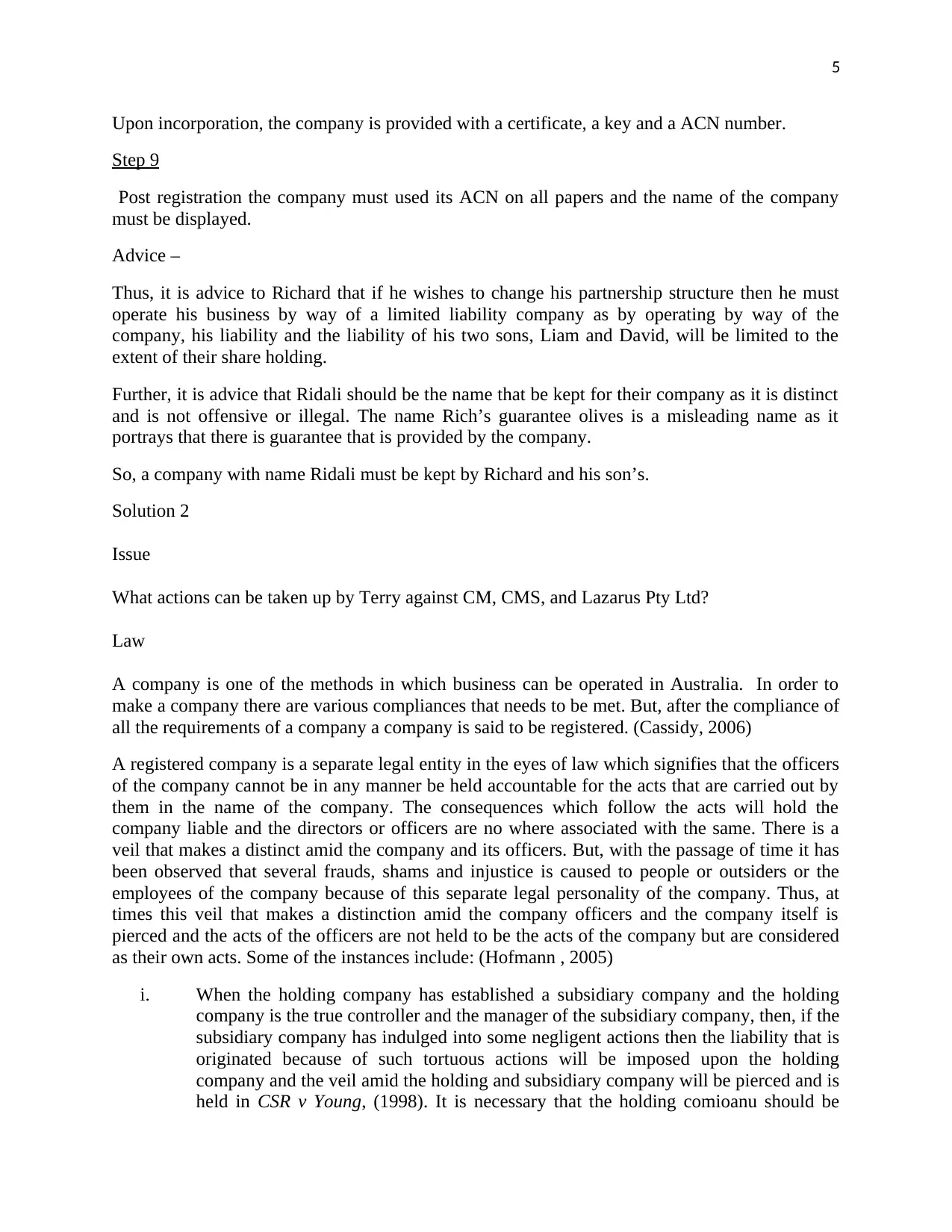
5
Upon incorporation, the company is provided with a certificate, a key and a ACN number.
Step 9
Post registration the company must used its ACN on all papers and the name of the company
must be displayed.
Advice –
Thus, it is advice to Richard that if he wishes to change his partnership structure then he must
operate his business by way of a limited liability company as by operating by way of the
company, his liability and the liability of his two sons, Liam and David, will be limited to the
extent of their share holding.
Further, it is advice that Ridali should be the name that be kept for their company as it is distinct
and is not offensive or illegal. The name Rich’s guarantee olives is a misleading name as it
portrays that there is guarantee that is provided by the company.
So, a company with name Ridali must be kept by Richard and his son’s.
Solution 2
Issue
What actions can be taken up by Terry against CM, CMS, and Lazarus Pty Ltd?
Law
A company is one of the methods in which business can be operated in Australia. In order to
make a company there are various compliances that needs to be met. But, after the compliance of
all the requirements of a company a company is said to be registered. (Cassidy, 2006)
A registered company is a separate legal entity in the eyes of law which signifies that the officers
of the company cannot be in any manner be held accountable for the acts that are carried out by
them in the name of the company. The consequences which follow the acts will hold the
company liable and the directors or officers are no where associated with the same. There is a
veil that makes a distinct amid the company and its officers. But, with the passage of time it has
been observed that several frauds, shams and injustice is caused to people or outsiders or the
employees of the company because of this separate legal personality of the company. Thus, at
times this veil that makes a distinction amid the company officers and the company itself is
pierced and the acts of the officers are not held to be the acts of the company but are considered
as their own acts. Some of the instances include: (Hofmann , 2005)
i. When the holding company has established a subsidiary company and the holding
company is the true controller and the manager of the subsidiary company, then, if the
subsidiary company has indulged into some negligent actions then the liability that is
originated because of such tortuous actions will be imposed upon the holding
company and the veil amid the holding and subsidiary company will be pierced and is
held in CSR v Young, (1998). It is necessary that the holding comioanu should be
Upon incorporation, the company is provided with a certificate, a key and a ACN number.
Step 9
Post registration the company must used its ACN on all papers and the name of the company
must be displayed.
Advice –
Thus, it is advice to Richard that if he wishes to change his partnership structure then he must
operate his business by way of a limited liability company as by operating by way of the
company, his liability and the liability of his two sons, Liam and David, will be limited to the
extent of their share holding.
Further, it is advice that Ridali should be the name that be kept for their company as it is distinct
and is not offensive or illegal. The name Rich’s guarantee olives is a misleading name as it
portrays that there is guarantee that is provided by the company.
So, a company with name Ridali must be kept by Richard and his son’s.
Solution 2
Issue
What actions can be taken up by Terry against CM, CMS, and Lazarus Pty Ltd?
Law
A company is one of the methods in which business can be operated in Australia. In order to
make a company there are various compliances that needs to be met. But, after the compliance of
all the requirements of a company a company is said to be registered. (Cassidy, 2006)
A registered company is a separate legal entity in the eyes of law which signifies that the officers
of the company cannot be in any manner be held accountable for the acts that are carried out by
them in the name of the company. The consequences which follow the acts will hold the
company liable and the directors or officers are no where associated with the same. There is a
veil that makes a distinct amid the company and its officers. But, with the passage of time it has
been observed that several frauds, shams and injustice is caused to people or outsiders or the
employees of the company because of this separate legal personality of the company. Thus, at
times this veil that makes a distinction amid the company officers and the company itself is
pierced and the acts of the officers are not held to be the acts of the company but are considered
as their own acts. Some of the instances include: (Hofmann , 2005)
i. When the holding company has established a subsidiary company and the holding
company is the true controller and the manager of the subsidiary company, then, if the
subsidiary company has indulged into some negligent actions then the liability that is
originated because of such tortuous actions will be imposed upon the holding
company and the veil amid the holding and subsidiary company will be pierced and is
held in CSR v Young, (1998). It is necessary that the holding comioanu should be
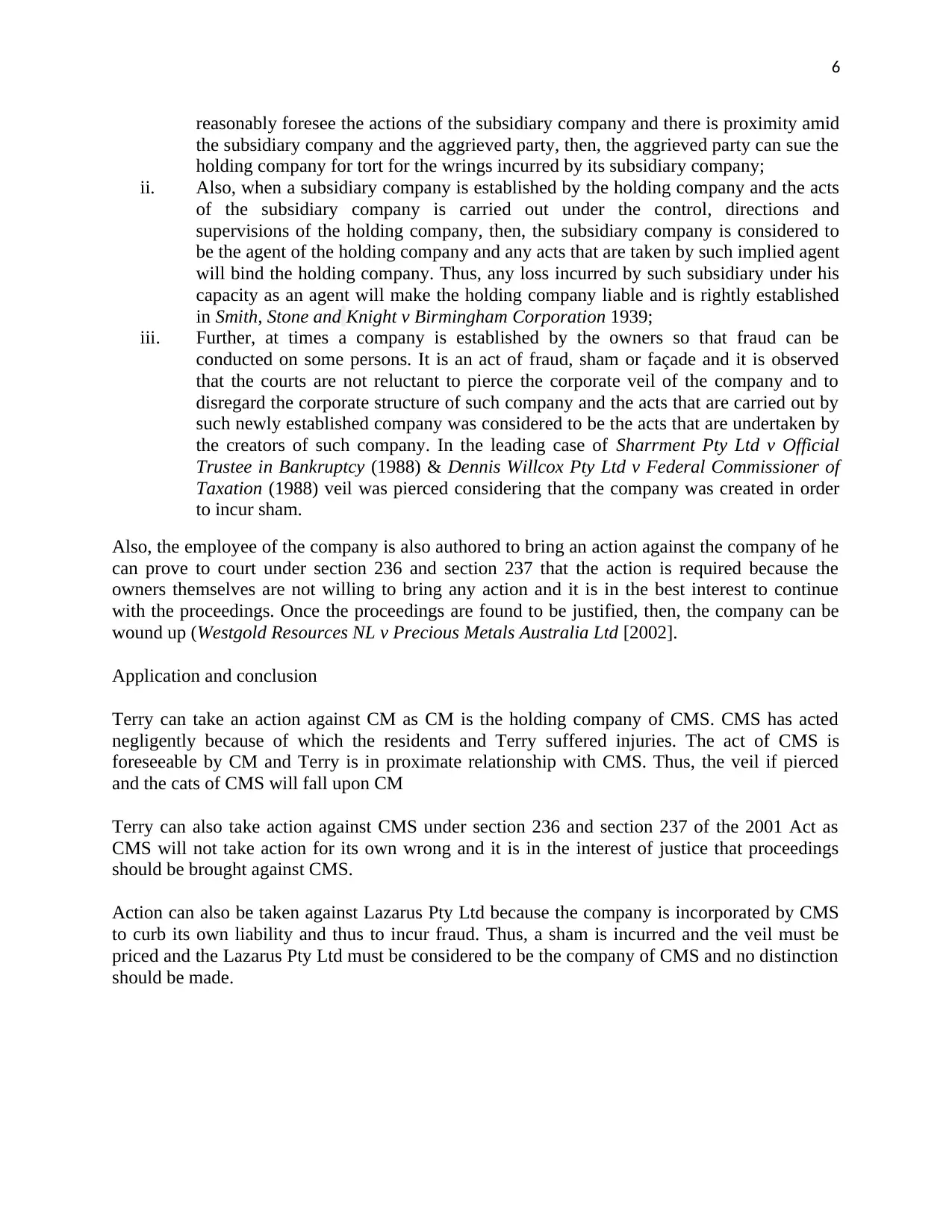
6
reasonably foresee the actions of the subsidiary company and there is proximity amid
the subsidiary company and the aggrieved party, then, the aggrieved party can sue the
holding company for tort for the wrings incurred by its subsidiary company;
ii. Also, when a subsidiary company is established by the holding company and the acts
of the subsidiary company is carried out under the control, directions and
supervisions of the holding company, then, the subsidiary company is considered to
be the agent of the holding company and any acts that are taken by such implied agent
will bind the holding company. Thus, any loss incurred by such subsidiary under his
capacity as an agent will make the holding company liable and is rightly established
in Smith, Stone and Knight v Birmingham Corporation 1939;
iii. Further, at times a company is established by the owners so that fraud can be
conducted on some persons. It is an act of fraud, sham or façade and it is observed
that the courts are not reluctant to pierce the corporate veil of the company and to
disregard the corporate structure of such company and the acts that are carried out by
such newly established company was considered to be the acts that are undertaken by
the creators of such company. In the leading case of Sharrment Pty Ltd v Official
Trustee in Bankruptcy (1988) & Dennis Willcox Pty Ltd v Federal Commissioner of
Taxation (1988) veil was pierced considering that the company was created in order
to incur sham.
Also, the employee of the company is also authored to bring an action against the company of he
can prove to court under section 236 and section 237 that the action is required because the
owners themselves are not willing to bring any action and it is in the best interest to continue
with the proceedings. Once the proceedings are found to be justified, then, the company can be
wound up (Westgold Resources NL v Precious Metals Australia Ltd [2002].
Application and conclusion
Terry can take an action against CM as CM is the holding company of CMS. CMS has acted
negligently because of which the residents and Terry suffered injuries. The act of CMS is
foreseeable by CM and Terry is in proximate relationship with CMS. Thus, the veil if pierced
and the cats of CMS will fall upon CM
Terry can also take action against CMS under section 236 and section 237 of the 2001 Act as
CMS will not take action for its own wrong and it is in the interest of justice that proceedings
should be brought against CMS.
Action can also be taken against Lazarus Pty Ltd because the company is incorporated by CMS
to curb its own liability and thus to incur fraud. Thus, a sham is incurred and the veil must be
priced and the Lazarus Pty Ltd must be considered to be the company of CMS and no distinction
should be made.
reasonably foresee the actions of the subsidiary company and there is proximity amid
the subsidiary company and the aggrieved party, then, the aggrieved party can sue the
holding company for tort for the wrings incurred by its subsidiary company;
ii. Also, when a subsidiary company is established by the holding company and the acts
of the subsidiary company is carried out under the control, directions and
supervisions of the holding company, then, the subsidiary company is considered to
be the agent of the holding company and any acts that are taken by such implied agent
will bind the holding company. Thus, any loss incurred by such subsidiary under his
capacity as an agent will make the holding company liable and is rightly established
in Smith, Stone and Knight v Birmingham Corporation 1939;
iii. Further, at times a company is established by the owners so that fraud can be
conducted on some persons. It is an act of fraud, sham or façade and it is observed
that the courts are not reluctant to pierce the corporate veil of the company and to
disregard the corporate structure of such company and the acts that are carried out by
such newly established company was considered to be the acts that are undertaken by
the creators of such company. In the leading case of Sharrment Pty Ltd v Official
Trustee in Bankruptcy (1988) & Dennis Willcox Pty Ltd v Federal Commissioner of
Taxation (1988) veil was pierced considering that the company was created in order
to incur sham.
Also, the employee of the company is also authored to bring an action against the company of he
can prove to court under section 236 and section 237 that the action is required because the
owners themselves are not willing to bring any action and it is in the best interest to continue
with the proceedings. Once the proceedings are found to be justified, then, the company can be
wound up (Westgold Resources NL v Precious Metals Australia Ltd [2002].
Application and conclusion
Terry can take an action against CM as CM is the holding company of CMS. CMS has acted
negligently because of which the residents and Terry suffered injuries. The act of CMS is
foreseeable by CM and Terry is in proximate relationship with CMS. Thus, the veil if pierced
and the cats of CMS will fall upon CM
Terry can also take action against CMS under section 236 and section 237 of the 2001 Act as
CMS will not take action for its own wrong and it is in the interest of justice that proceedings
should be brought against CMS.
Action can also be taken against Lazarus Pty Ltd because the company is incorporated by CMS
to curb its own liability and thus to incur fraud. Thus, a sham is incurred and the veil must be
priced and the Lazarus Pty Ltd must be considered to be the company of CMS and no distinction
should be made.
⊘ This is a preview!⊘
Do you want full access?
Subscribe today to unlock all pages.

Trusted by 1+ million students worldwide
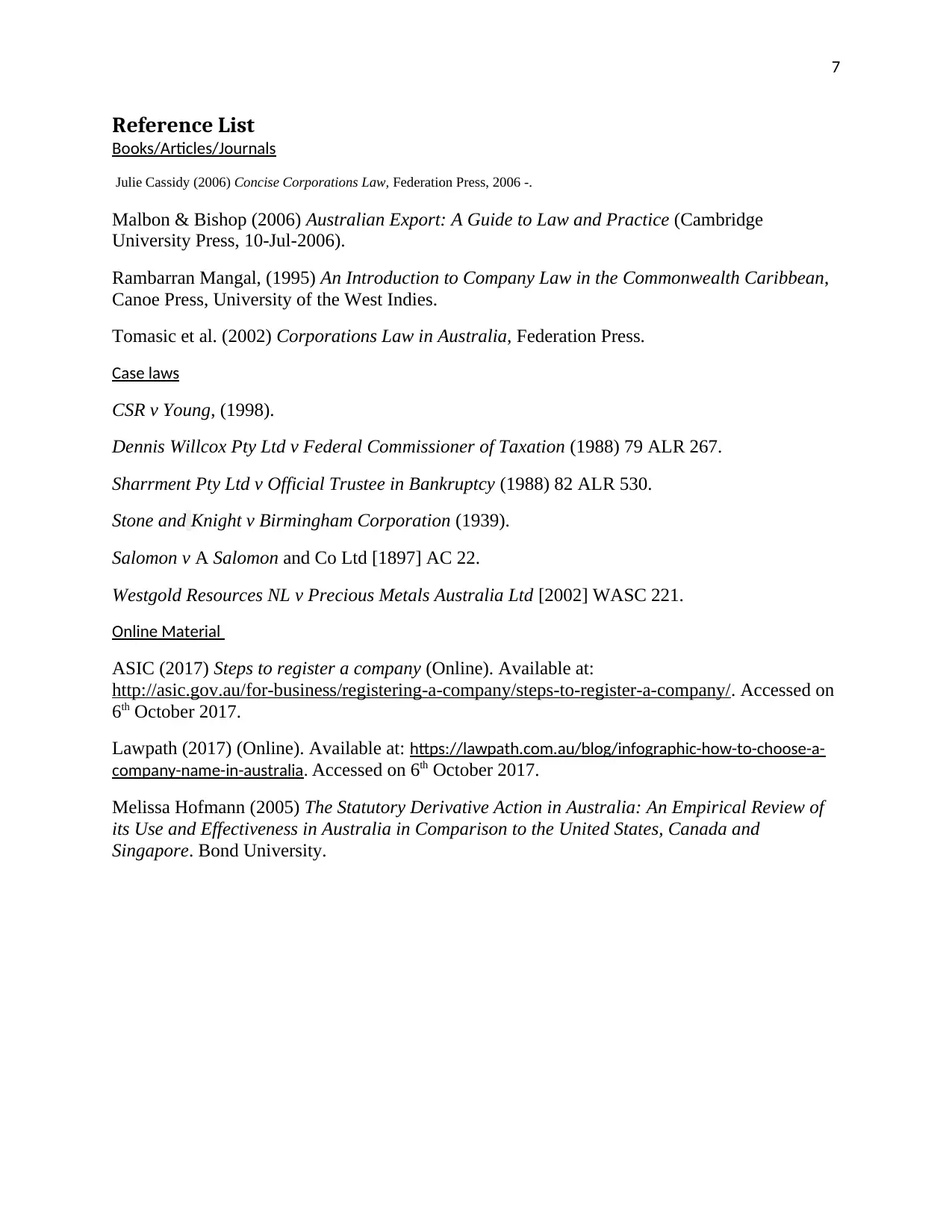
7
Reference List
Books/Articles/Journals
Julie Cassidy (2006) Concise Corporations Law, Federation Press, 2006 -.
Malbon & Bishop (2006) Australian Export: A Guide to Law and Practice (Cambridge
University Press, 10-Jul-2006).
Rambarran Mangal, (1995) An Introduction to Company Law in the Commonwealth Caribbean,
Canoe Press, University of the West Indies.
Tomasic et al. (2002) Corporations Law in Australia, Federation Press.
Case laws
CSR v Young, (1998).
Dennis Willcox Pty Ltd v Federal Commissioner of Taxation (1988) 79 ALR 267.
Sharrment Pty Ltd v Official Trustee in Bankruptcy (1988) 82 ALR 530.
Stone and Knight v Birmingham Corporation (1939).
Salomon v A Salomon and Co Ltd [1897] AC 22.
Westgold Resources NL v Precious Metals Australia Ltd [2002] WASC 221.
Online Material
ASIC (2017) Steps to register a company (Online). Available at:
http://asic.gov.au/for-business/registering-a-company/steps-to-register-a-company/. Accessed on
6th October 2017.
Lawpath (2017) (Online). Available at: https://lawpath.com.au/blog/infographic-how-to-choose-a-
company-name-in-australia. Accessed on 6th October 2017.
Melissa Hofmann (2005) The Statutory Derivative Action in Australia: An Empirical Review of
its Use and Effectiveness in Australia in Comparison to the United States, Canada and
Singapore. Bond University.
Reference List
Books/Articles/Journals
Julie Cassidy (2006) Concise Corporations Law, Federation Press, 2006 -.
Malbon & Bishop (2006) Australian Export: A Guide to Law and Practice (Cambridge
University Press, 10-Jul-2006).
Rambarran Mangal, (1995) An Introduction to Company Law in the Commonwealth Caribbean,
Canoe Press, University of the West Indies.
Tomasic et al. (2002) Corporations Law in Australia, Federation Press.
Case laws
CSR v Young, (1998).
Dennis Willcox Pty Ltd v Federal Commissioner of Taxation (1988) 79 ALR 267.
Sharrment Pty Ltd v Official Trustee in Bankruptcy (1988) 82 ALR 530.
Stone and Knight v Birmingham Corporation (1939).
Salomon v A Salomon and Co Ltd [1897] AC 22.
Westgold Resources NL v Precious Metals Australia Ltd [2002] WASC 221.
Online Material
ASIC (2017) Steps to register a company (Online). Available at:
http://asic.gov.au/for-business/registering-a-company/steps-to-register-a-company/. Accessed on
6th October 2017.
Lawpath (2017) (Online). Available at: https://lawpath.com.au/blog/infographic-how-to-choose-a-
company-name-in-australia. Accessed on 6th October 2017.
Melissa Hofmann (2005) The Statutory Derivative Action in Australia: An Empirical Review of
its Use and Effectiveness in Australia in Comparison to the United States, Canada and
Singapore. Bond University.
1 out of 7
Related Documents
Your All-in-One AI-Powered Toolkit for Academic Success.
+13062052269
info@desklib.com
Available 24*7 on WhatsApp / Email
![[object Object]](/_next/static/media/star-bottom.7253800d.svg)
Unlock your academic potential
Copyright © 2020–2025 A2Z Services. All Rights Reserved. Developed and managed by ZUCOL.





